Link building is an area plagued with bad information.
One site tells you this. Another tells you that. And, you come away from the screen six blog posts later no more informed than when you went in.
Which means you’ve got a massive headache, and you’re no closer to solving the problem, are you?
Well, today, I’m putting an end to that.
I’ve put together this no bullshit guide to helping you build organic, quality links, that Google can’t help but love. Each and every time.
Table of Contents
What You’ll Learn
I’ve tried to make sure all the content here is actionable. But there are a few sections that are there to give you a swift kick-in-the-ass too, because sometimes that’s exactly what you need.
But, before we go into that, let’s look at the key points you’ll learn:
- Why not branding your ideas is costing you hundreds of links
- How to hack Wikipedia (and get away with it)
- A foolproof way to make sure your blog posts don’t suck
- A guide to creating resource posts that people care about
- Much, much more…
If you’re ready, reach for that ‘bookmark’ button, and settle in for a good read. It’s going to make the world of difference to your SEO.
#1: The Skyscraper Technique
Content curation – coming up with good content ideas – is one of the hardest parts of SEO.
Because, well, while you probably love the technical aspects of SEO. But you’re not all that great on the creativity front.
And it sometimes feels like every piece of content you can think of has already been done, doesn’t it?
Well here’s the truth about that:
It has.
Every idea you can come up with or write about with confidence – unless you’re a real pioneer in a niche – has been done. But, that’s not bad news for you. In fact, that’s great news.
Because it means that you don’t have to worry about coming up with original ideas anymore. It means you can use the ones out there, and make them better.
Which is exactly what Brian Dean’s Skyscraper Technique is all about.
Taking ideas that are already proven to work and building on them with your own valuable insight and experience.
There are two ways you can do this:
- The Google Way
- The Buzzsumo Way
Let’s look at both…
The Google Method
Let’s say you already have a long-tail keyword you want to rank for. Or, you have a topic in mind that you want your site to rank well for.
Simply take it, and type it in Google.
For this, I’ll use the Photography niche:

And take a look at all the content that comes up:
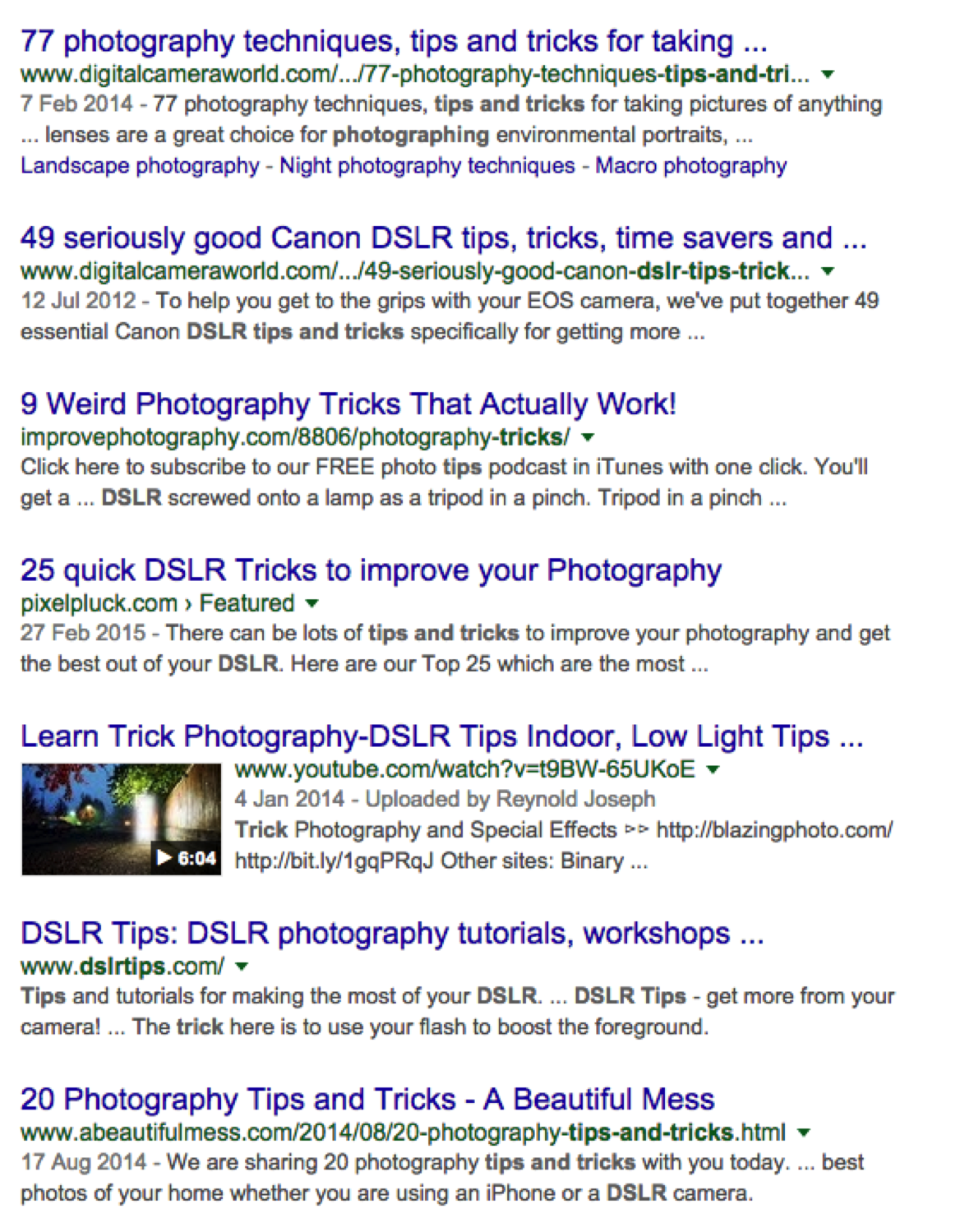
From here you can choose the content that suits your needs best – landing pages, blog posts, sales copy etc. – and make them better.
Simple. Quick. Effective.
The BuzzSumo Method
This is perfect if you’re looking to create backlinks through your blog posts.
Much like the Google method, take a topic or keyword or idea, and search it in BuzzSumo.
So, for the Photography niche again, let’s say I wanted to created content around Travel Photography, I would search it in BuzzSumo:

And look for the content that has the most shares, or the most buzz around it. Which means these top five results would be a good place to start:

Skyscraper In Action…
Let’s look at the 9 Weird Photography Tricks That Actually Work from the Google Method.
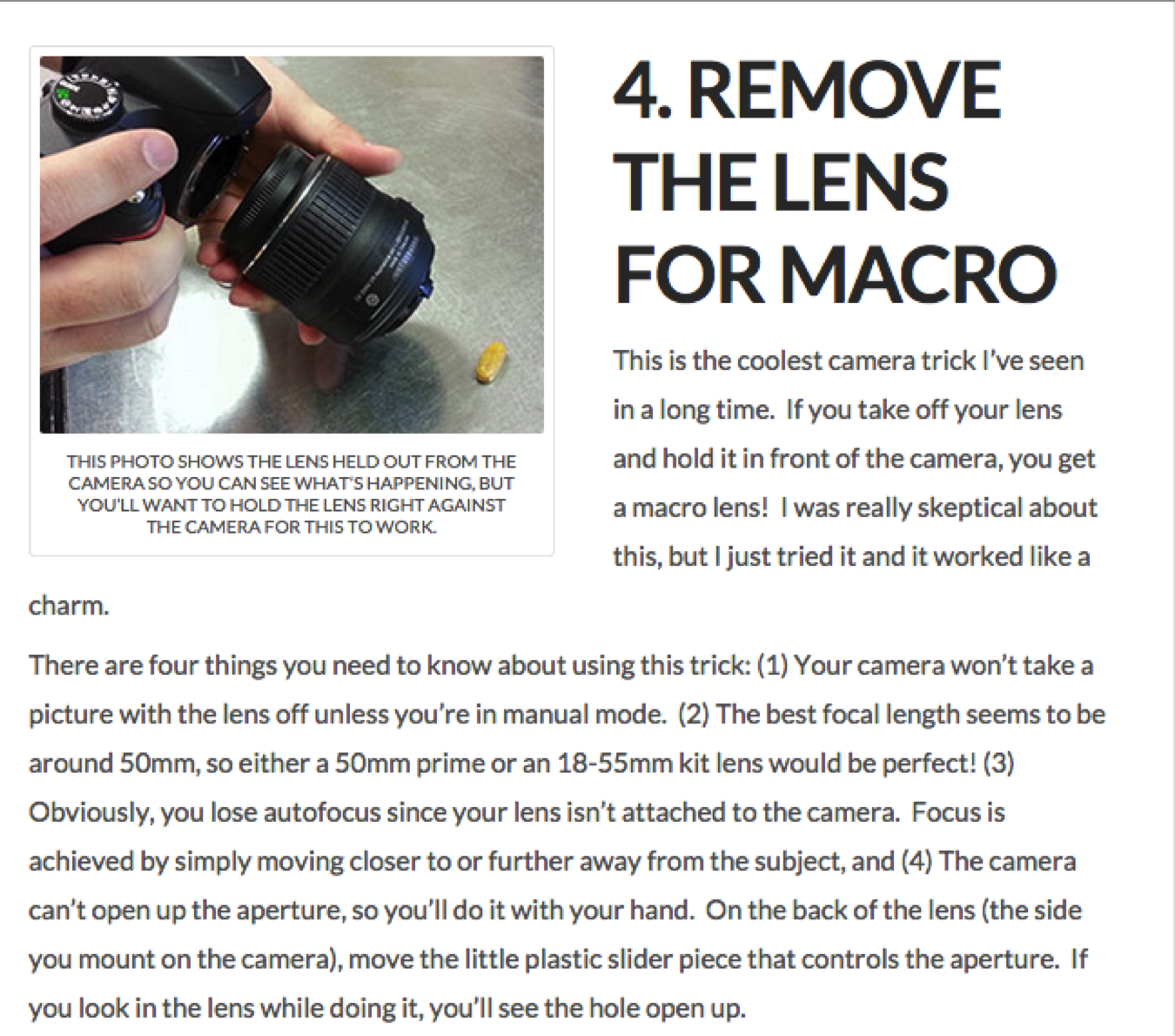
From reading the article I can gather a few things:
- The content is good, but it’s missing a few key points
- It’s poorly laid out
- Not every point is actionable
- There are no ‘results’ pictures, or evidence, for each of the steps
- Nine is a bad number to end on, when you’re so close to the 10 sweet spot
Which means that I already have five ways to improve that article, without needing an original idea:
- Add in extra depth to points already made (or add my own spin)
- Improve the layout
- Create specifically actionable points
- Show results of each of the tricks
- Find a way to make it to 10 points
Not bad for less than 10 minutes research, right?
Don’t Skimp On Quality Though…
While these methods are simple, this isn’t about a shortcut to create just another bad blog post.
The idea here is to build on content and create killer content that people want to link back to. The posts you find in your research are good – and you’ve got less to worry about with idea curation – but your real job is to make this posts epic.
Which brings me, nicely, on to my next point…
#2: Stop Writing Bad Content
This is the no BS guide for a reason. Because I’m going to call you out on some of the crappy stuff you’re doing whenever I get chance.
And I want to call you – and the rest of the Internet – on this:
Stop writing bad content.
Not sure what I mean by bad content? Well, here are a few symptoms:
- It’s boring
- It’s poorly researched
- It doesn’t add value
- It’s saying the same as everyone else
- It doesn’t stand out from the crowd
Sound like your content? If you swallow your pride, you might find that it is.
The Truth About Writing Backlink-able Content
You don’t need to be a writer to create killer content.
In fact, some of the most successful content creators on the Internet wouldn’t consider themselves writers.
They’re entrepreneurs, like Neil Patel. SEO experts like Matt Woodward. And marketers and strategists like Robbie Richards.
And while they possess the ability to write, they aren’t writers. They don’t live and breathe writing in the same way Ernest Hemingway or J.K Rowling does.
But that they do, with every post, is add incredible value.
They change someone’s trajectory – even if only for a moment – with every post. They go above and beyond what’s expected of content. Because that’s what’s important to them, and to their audience.
Way back in 2010, Corbett Barr the CEO of Fizzle, wrote this post called Write Epic Shit.
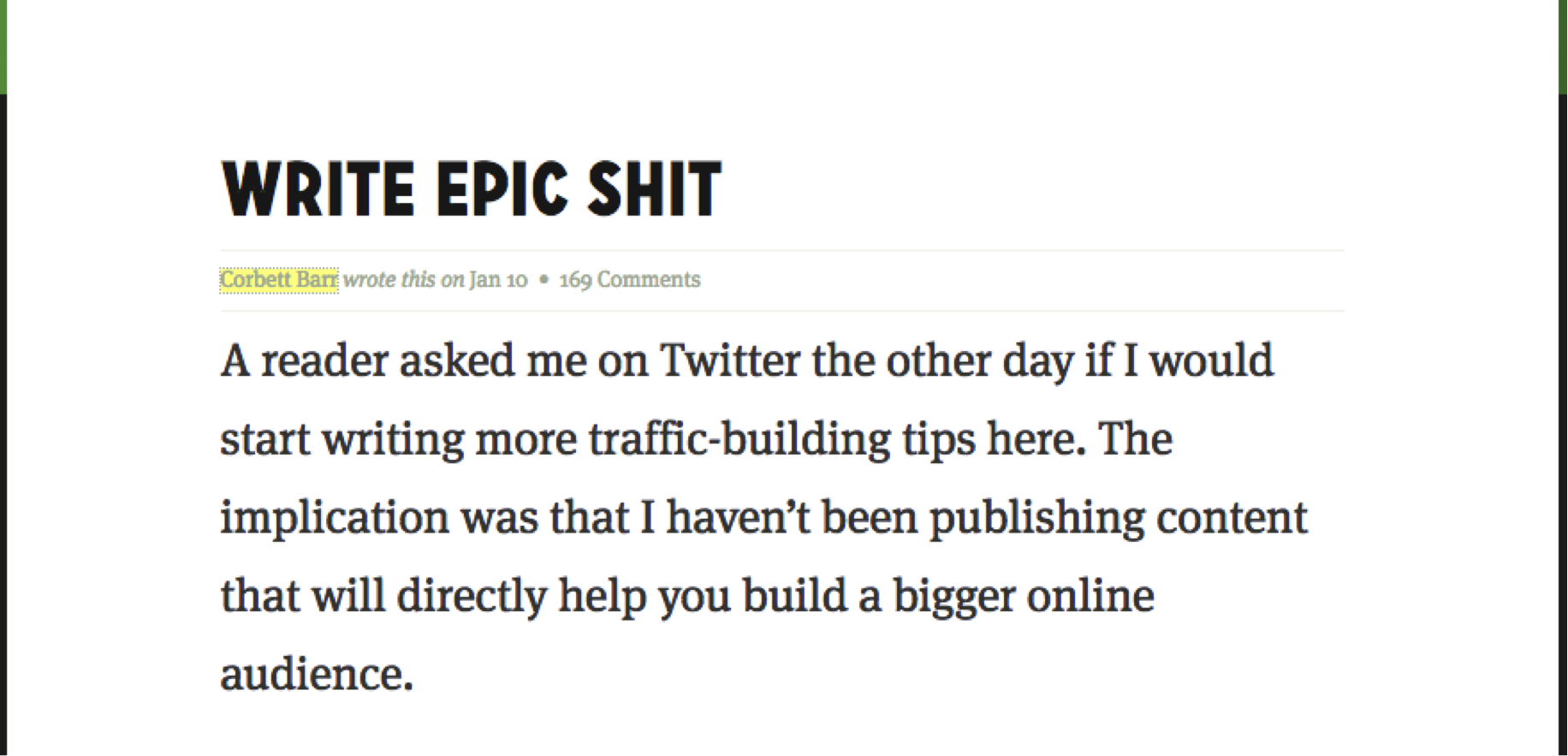
In it is a call to action to every blogger, writer, entrepreneur and schmuck with a keyboard to write epic content. Content from the heart. That comes from experience. That adds value and changes the person at the other end.
And if you want to create organic links, from influencer sites that matter, that’s the approach you need to take to.
So don’t let your blog post just full another space on your site. Or just be there because you have one more page to index. Make sure it creates a strong and valuable connection with the reader.
#3: Find Broken Wikipedia Links
This is one of my favourite methods, because it almost feels like a cheat code.
Broken links are white hat, they’re easy to outsource and you can generate a lot of backlinks in a small space of time.
There are a few ways you can do this, but this is the most effective way I’ve found with clients – and that SERPed users – have done to leverage this:
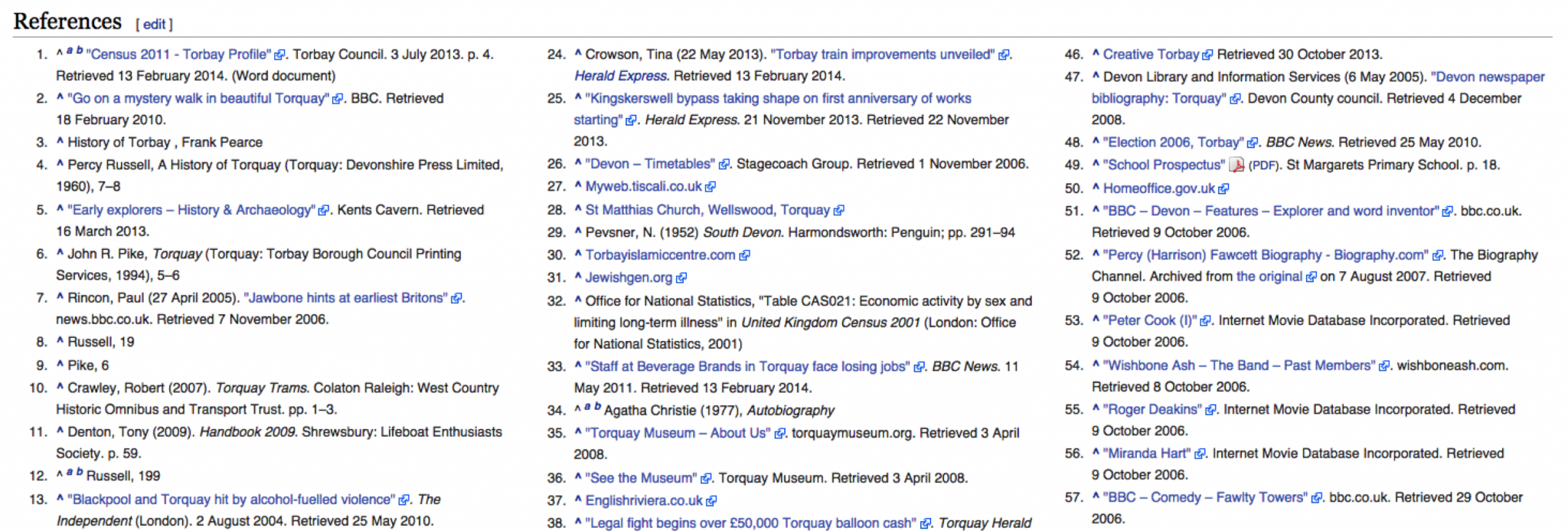
Head over to WikiGrabber and search a topic, or keyword, you want to rank for.
For simplicity, I’ve kept this pretty broad, and searched, ‘Coffee’:

That’s going to bring you up a page filled with dead links and pages that need citations. But for now, we’re going to focus on the dead links.
Choose a page that you think will fit some of the content you have on your site. For my hypothetical coffee site, I’ve gone for a page about espresso:

Now when you get on the page, the broken link may not be obvious to you. Because, well, you’re not psychic.
So hit ctrl + f to bring up the find tool, and type in ‘dead link’:

And, hey presto, there it is:

This might not be the perfect page for you first time. So you may have to do that process a few times until you find a link that works for the content you’ve got.
But once you do find that link, this isn’t the end of the road. In fact, the purpose here isn’t really to get on the Wikipedia page.
It’s to find everyone that’s pointing to that link. Because, if it’s on Wikipedia, chances are it’s a valuable link.
Copy and paste the link into the ‘Site Analyser’ section of SERPed (or your current tool), and look for the backlinks that point to that page:
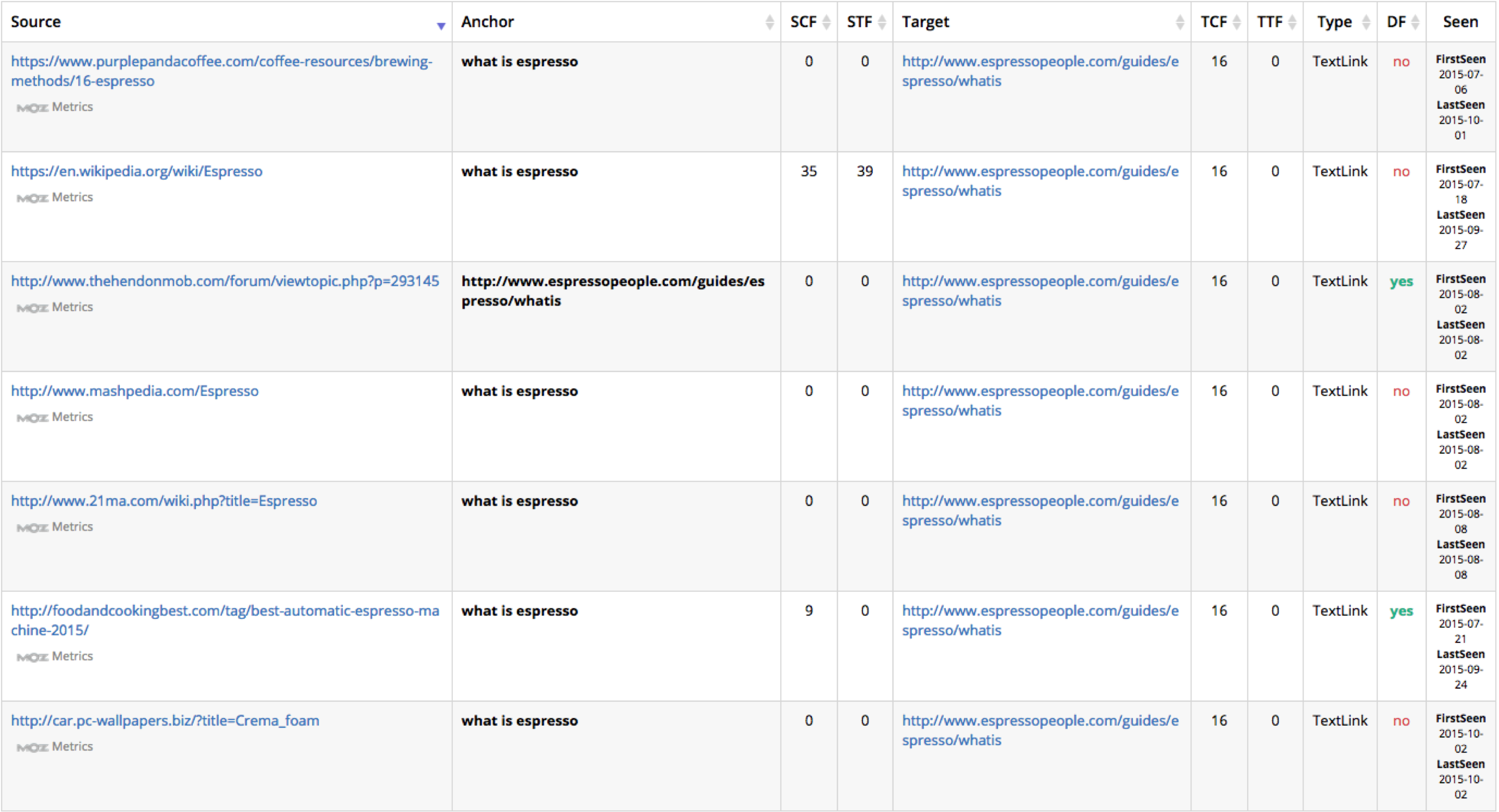
Now, all you need to do is look for the ‘contact’ page on these sites, and let them know about their broken link.
And, that you have the perfect piece of content to fill that void.
#4: Take The Clever Approach To Guest Posts
When Matt Cutts said Guest Posting was dead, a large portion of the SEO community took a step back from it.
And, while it may be true that guest posting isn’t as effective as a growth tool as it was in the early days of blogging.
Like how Chris Guillebeau used it to built The Art on Non Conformity in less than a year. The truth is that it’s still a powerful tool, if you’re smart about it.
Take a look at this list, and tell me who it applies to – Google, or People?
- Hates spammy content
- Won’t pay attention to duplicate content
- Thinks content from a trusted site is better
- Cares about which influencers are sharing what content
- Is only focused on one end product, which is value.
So, who does that apply to?
Okay, okay. You got me. It was a trick question. Because it applies to both people and Google.
If you write crummy guest posts – see point #2 – of course Guest Blogging is dead to you. Because you’re spouting the same old tripe they could read elsewhere.
But if you write killer, epic, value driven guest posts, on a site that’s trusted in your niche, you’ve got a winning strategy.
Raise Your Standards
There’s good news, and bad news, right here:
The bad news is that you’re going to need to raise the bar of the sites you write for. You can’t just get featured on any old blog, with any old post, anymore.
The good news is that a lot of agencies still think you can.
Which means that as of right now, you’re ahead of the game. Because while they’re still trying to churn out content on bad blogs, you can focus your effort on the good ones.
Look for blogs that have:
- High levels of links pointed towards them
- Rank highly for specific keyword, or content types
- That have influencers with a big social media presence
- Whose posts have lots of comments
- Have good-to-high levels of shares on each post
#5: Create Powerful Resource Posts
I’m sure you’ll agree with me when I say:
I’m sick to death of resource posts.
That is to say I’ve read enough blog posts about blog posts that I should be reading to do me until I die.
Not only are they light on content; they’re light on value. Which means that, nowadays, people are less likely to link back to them.
Which brings you to the elephant in the room…
Why am I telling you to write resource posts, then?
Plain and simple, it’s because resource posts aren’t a bad medium. In fact, they make for great content. The problem is that they’ve becomes tired and boring. Which means it’s time for a different type of resource post.
For example, take a look at this resource post from the guys over at Buffer:

Instead of being just another, “50 Productivity Blogs You Should Read” post, they changed the dynamic.
By asking their readers for their insight – and giving them chance to participate in a post on one of their favourite blogs – they gave their readers ownership. And, gave them a vested interested in the success of the post.
On the flip side, as a reader, it’s intriguing. Because not only am I finding out valuable information of blogs that could make me more productive, I’m getting an insight into which Buffer’s audience cares about too.
And, for one not-a-lot-of-content resource post, it’s got a lot of backlinks in just a few weeks.
Here are a few more ideas for resource posts, based on successful ones that you can use for your blog:
- The Free Productivity Apps We Use Everyday: Readers love apps. App owners love to share, and backlink, to these kinds of posts. This has in-built promotion and will generate a lot of interest.
- 45 Experts Share Their Insider Knowledge: Expert round ups can sometimes be dangerous. Because, if they’re not well written, they don’t do too well. But what they are great for is social media backlinks. Influencers can (and will) share these posts on their feeds.
- 50+ Resources To Help You Create Blog Images: These posts are benefit oriented. They not only give you an attractive list of tools, but they give you a desired outcome too.
#6: Brand Your Ideas
Branding your ideas is one of those, “Aha!” moment. Because it seems so damned obvious after you’ve thought about it.
Let’s say you have a great idea for a product, a service, or a method that you want to share with the world.
Do you send it out into the world under a generic name?
Or do you give it a snap, crackle and pop name that people will remember?
Reading this post now, you know for sure it’s the second one. But you’d be surprised how many people – yourself included – that send their ideas out into the world under generic titles.
Let’s take a look at the power of branding your ideas from an example in this very post.
In point #1, you read about The Skyscraper Technique from Brian Dean:
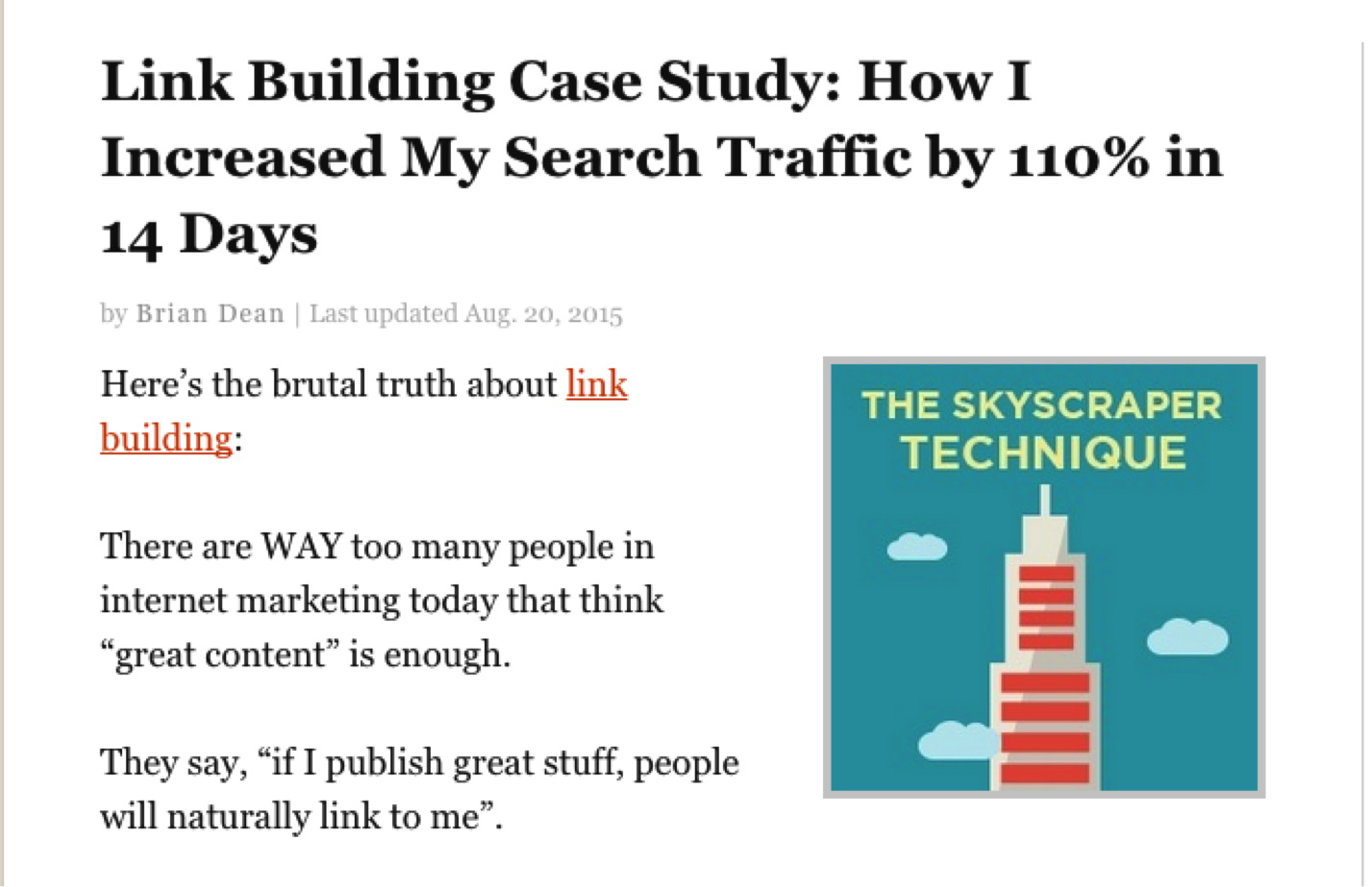
Now he could just have easily have written a blog post that said:
- Why you should steal your competitor's ideas
- The simple method to get more backlinks
- How to look at other blogs most successful posts and use their content to drive you own ideas and create better blog posts in the long term
- …Okay, maybe not that last one.
But he didn’t. Instead he gave it a punchy, hard-hitting name that people would remember. And, whenever you think of taking an idea and improving on it, you’ll think of that name.
And in terms of SEO results, it’s phenomenal. That one single post for the Skyscraper Technique has nearly 390 backlinks. And not just from any old sites either.
In fact, when I took the post to BuzzSumo for a quick analysis on shares, the first result comes from QuickSprout (arguably one of the most respected sites in his niche), and got 7400 shares all by itself.
Not only does that give you a lot of credibility for your idea. It gives you a massive surge in rankings too.
There’s also another nice side effect from this too – you create your own keywords.
Which means that you’re almost guaranteed to be on the first page for that search. And, when enough people get wind of it, it’ll be a powerful stream of organic traffic all by itself.
#7: Blogger Reviews
I can’t even begin to tell you how stupidly easy a way to build backlinks this is.
But it’s one that a lot of SEO’s overlook. Because, well…I have no idea.
Maybe it’s the fact it takes time. Perhaps they don’t quite believe in their product. Or, maybe, they just don’t like taking the obvious route.
But the truth is:
Product reviews are like guest blogging without the hard work.
You don’t need to write an article. You don’t need to curate content. And, you don’t need to do any grunt work other than sending a few emails.
Choose an influencer, give them access to your product and let them bash away at the keyboard for you.
Recently I asked Matthew Woodward to review my product, SERPed, over on his blog:
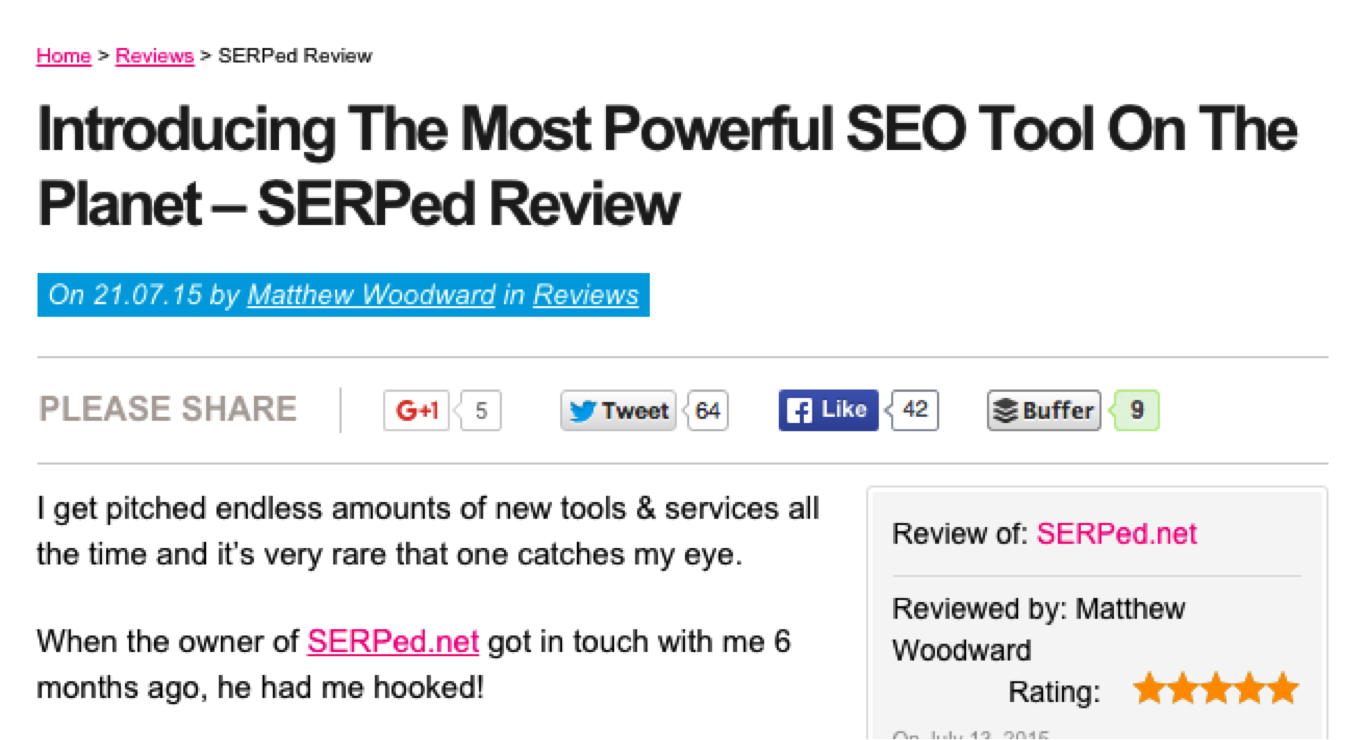
Not only did this give me exposure to thousands of engaged readers. It gave me another organic backlink from a well-respected site, to my product.
And, thankfully, he gave it five stars. Which means that the traffic numbers that came from that post alone were worth it.
Getting bloggers to review your products isn’t hard, either. Because if there’s one thing that’s true about Bloggers, it’s that they love free stuff.
Granted, the more lucrative the blog, the more work you have to put in. But putting in the manual labour to get these reviews pays dividends at the other end.
Not only is that link worth it’s weight in gold, but so is the satisfaction of someone telling their entire audience to pay attention to your product.


